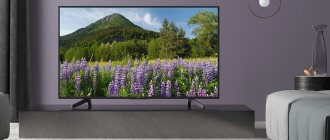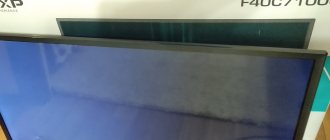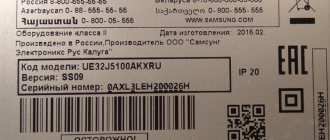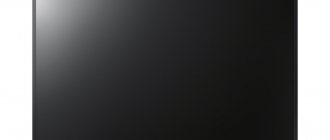The Samsung and Sony brands are known throughout the world. Their TVs are popular, but each brand has its supporters and opponents. If you compare models from both companies, you can understand that they have a lot in common, but there are also differences, which we will look into.
Both companies are direct competitors of each other, which annually release updated models and even TV lines. The wealth of choice only complicates the purchase when you need good equipment at a reasonable cost. The comparative analysis will help highlight the features of each brand and make the right choice.
Pros and cons of Sony TVs
The Japanese brand is very popular and successful in the market; it produces mobile phones, cameras and other popular equipment, which can be attributed to the company’s big advantages. The main disadvantage of TVs from this manufacturer is the inflated price. Sony does not produce models in the budget price segment at all.
Modern TVs are created using the most advanced technologies, but often users simply cannot appreciate them in reality due to lack of content, low Internet speed or poor-quality TV signal. It's obvious that you're overpaying for unnecessary features.
In terms of build quality, Sony TVs have always been ahead. It is produced in Slovakia and Malaysia.
There are several more advantages of this brand’s TV equipment:
- Numerous image processing – perfect picture;
- High quality dynamic scenes without flickering, delays or distortion;
- Clear detailed image;
- Powerful sound, often the presence of a subwoofer;
- Wide viewing angle without distortion;
- Real deep black color;
- Uniform Direct LED illumination;
- 3D support (in older models);
- OS Android.
Among the disadvantages, the following can be noted:
- Overpriced even for models from previous years;
- Russian buyers really won’t be able to appreciate 80% of the TV’s capabilities;
- One-year warranty, the extension of which must be paid for;
- No QLED screens;
- Inconvenient remote control with no instructions.
Comparing the best
To get an idea of how competitive the brands in question are with each other, let’s compare several TV models that were released in 2021 and took leadership positions in their segment.
| The product's name | Screen diagonal, cm | Permission | Sound | Smart TV | Additional options | |
| Popular models | Samsung UE32J4000AU | 81 | 720 Full HD | Dolby Digital, stereo | absent | 4 |
| Sony KDL-48WD653 | 122 | 1080 Full HD | Dolby Digital, stereo | present | 7 | |
| New items | Samsung UE40K6000AU | 102 | 1080 Full HD | Dolby Digital, DTS, stereo | present | 7 |
| Sony KD-65ZD9 | 164 | 4K UHD, HDR | Dolby Digital, stereo | present | 9 |
Pros and cons of Samsung TVs
The South Korean brand entered the market earlier than its opponent, and it is more consumer-oriented than Sony. TV models satisfy buyers with price and functionality. TV equipment is assembled in Russia, the build quality is high, and the products last for decades. All equipment parts are manufactured and designed at company factories, that is, the full production cycle is covered.
One of the important differences between Samsung and its competitor is the production of goods in different price categories. Budget options are in no way inferior to premium models in image quality. Display diagonals for every taste - from 19'' and above.
Samsung has its own Tizen operating system. Most modern models support voice and even gesture control.
It is worth noting other advantages of Samsung TVs:
- Realistic color rendering;
- Clear touch remote control;
- Uniform illumination makes viewing comfortable even in a brightly lit room;
- Contrasting image;
- Decent sound from the built-in audio system;
- Many models with curved screen;
- Wide viewing angle.
There are also disadvantages:
- One-year warranty, which can be extended to 2 years for an additional fee;
- OLED screens are not produced;
- High power consumption.
| DOLBY VISION VS HDR 10+
If you're buying a mid-range or higher TV, it will likely support high dynamic range (HDR), but what you may not know is that HDR comes in several different forms.
Every HDR TV supports the base HDR10 format, which offers a wider color gamut and improved contrast compared to conventional SDR TVs. Currently, most television content is still in SDR format, but every year more and more films, TV series and programs are switching to HDR.
Additionally, there are two HDR formats that add "dynamic metadata" to enhance the broadcast TV picture by changing the TV's picture settings relative to the scene you're watching and the type of picture on screen.
The first was Dolby Vision, supported by Sony as well as LG, and you could also find it on TVs from Vizeo, TCL and Hisense. Then there's HDR10+, which is supported by Samsung and Panasonic - although the latter is willing to offer both formats on its mid-range and premium TVs.
Dolby Vision is indeed a more advanced format with a 12-bit color gamut instead of the 10-bit HDR10+, which is also more common. And while Amazon Prime has HDR10+ support for some shows, you won't find HDR10+ support on Netflix or on Chromecast Ultra and Apple TV 4K.
Admittedly, the preferred HDR format only really matters at the top end of the price range, but big-spending users should think carefully about what services they're likely to need for HDR content.
Comparison of Sony and Samsung TVs by main characteristics
Having briefly studied the advantages and disadvantages of a particular brand, it is difficult to make a final decision about which TV is better. Therefore, it is important to evaluate the main characteristics of the product, take into account the opinions of experts and not ignore real reviews from product buyers.
Design
The peculiarity of Sony TVs is their classic design, which has not changed for a very long time. Frameless models are very similar to Samsung, but differ in the stands. This is a choice for those who like simplicity without frills.
Samsung has a different design policy. Ultra-modern televisions with frames of different shapes, sizes and colors regularly appear on the shelves. The shape of the case itself is also different, not to mention the stands.
Both companies strive to minimize the frames and thereby increase the diagonal. There will be no significant differences in the design of TVs from opposing companies. The metal edging protects the display from accidental impacts, so its presence or excessive thickness should not be considered a disadvantage.
Diagonal
Sony produces TVs with a diagonal of at least 32'' and up to 85''. Samsung offers consumers models with a minimum diagonal of 19'' and up to 98''. The Koreans win here because their catalog has different options for every taste and budget. Screens of innovative models from Sony with a full range of technologies and functions are not produced smaller than 55''.
4K HDR TVs do not limit the distance from the user; they can be viewed almost closely.
Picture quality
The user is unlikely to notice the difference in picture quality if he compares two competing TVs of the same price category. Sony comes out a little ahead due to its HDR image processing technology, but this difference is only noticeable when conducting a light test.
Both companies are trying to produce high-resolution displays, so they practically no longer produce HD TVs, but they are still found in the budget segment of Samsung. Brands are more focused on creating 4K and . Full HD screens remain especially popular, this is explained by the reasonable price of such equipment.
If you compare competitors' products based on picture quality, the result will be ambiguous. Both brands will pass shade testing successfully, but Sony's anibrec system works better.
The realism of color reproduction is better in Samsung, but its competitor has excessively high saturation, and the brightness is slightly higher than normal, but this contrast is good for evening movie watching. The driving dynamics are well conveyed in both brands, but the highest indicator is in Korean premium vehicles.
The results of various tests indicate that Samsung TVs have a high motion transmission speed and a wide range of settings, which is important when choosing a model to connect a game console.
Sony is not far behind, and the new 2021 TVs with Football Match mode provide improved images that allow you to clearly see all the details of the sporting event. There is no trailing, no jitter, or any other distortion. Interaction with new generation game consoles also works well.
There are no significant differences at this point; experts recommend focusing on high resolution when choosing.
Matrix
Both companies use a liquid crystal LED matrix with LED backlighting. But the manufacturing methods are different. Sony uses only high-end VA matrices, so the brand does not have PLS or PVA displays. This adds to the cost of production, but the screen displays a bright, true-to-life image and is free from distortion when viewed from any angle. Thanks to the HDR system, both the dark and lightest areas of the image are equally visible on the screen.
Samsung most often uses PLS and PVA matrices. Because of this, the viewing angle is somewhat limited and the perspective is distorted when watching TV at a long distance. But the new QLED models use Ultra Viewing Angle technology, which greatly improves picture quality when viewed at an angle.
The Japanese win here because they do not waste their time on trifles. Of these, OLED TVs are the best option. Thanks to thousands of LEDs, light transmission is increased, natural colors are produced, and the picture is clear and realistic.
QLED production technology is somewhat behind OLED, but their price is much more attractive. The best way to choose a matrix is to evaluate it with your own eyes in a store. If this is not possible, then choose an OLED TV.
Sound
There will be no losers in the sound competition - both brands are at a high level. You need to choose according to the purpose of the TV - to watch TV channels, Dolby Digital from Sony is enough, and for more powerful sound, Samsung has models with several pairs of speakers and subwoofers. To get professional stereo sound, you will have to additionally connect external speakers.
3D support
Both companies moved away from 3D technology due to the fact that it simply became irrelevant, but there are still “old” models on sale that support active or passive 3D and they are sold complete with glasses. These are models from 2011-2015.
Remote Control
Samsung wins here, since Sony is “famous” for its clunky remote controls, which take a long time to understand. And the menu itself is not ideal either. The remote control often slows down, and the TV takes a long time to process its signal. There are a lot of extra buttons that are simply not used, and working with Smart TV is not very convenient.
With Samsung it’s the other way around – a laconic, easy-to-understand remote control, and in expensive models there’s even a touchscreen one.
Additional functions
The equipment and functionality largely depend on the price of the TV. Both companies offer customers models with 3D support, Wi-Fi and Smart TV function. Sony interacts perfectly with tablets and smartphones, does not “slow down” or freeze during operation.
Samsung is pleased with its intuitive interface, understandable even to the elderly or children. But the work of pre-installed applications is sometimes unstable. Sony's optimization is better, but the opponent is not far behind.
Also, depending on the year of manufacture, cost and configuration, such functions may be available:
- voice and gesture control;
- curved screen;
- teletext;
- additional installed applications.
Some Sony TV models even support Google Assistant.
| SMART TV: TIZEN VS ANDROID TV
Smart platform Sony, Android TV.
Each TV manufacturer typically has different Smart TV platforms, each with its own unique features.
Samsung releases Tizen OS for mid-range and premium TVs. Tizen is quick to navigate and generally uncluttered, with a constantly refreshed Recents window that lets you keep track of your most frequently used apps. Overall, the interface offers a fairly competent experience, although the universal search function isn't as powerful as LG's webOS platform.
Sony, on the other hand, uses Android TV, which offers slightly more content and menu bars than its rival. The slightly more cluttered interface nevertheless offers more at your fingertips. The choice here is more down to your preferences - although Android TV is notoriously a fussier system that's more prone to glitches than other smart TV platforms.
But what about voice assistants? Sony's new TVs will come with Google Assistant integrated - which makes sense considering Android TV is a platform developed by Google.
However, Sony has added the Amazon Alexa Music, Camera and TV Control app to its 2021 TVs, including some mid-range models from previous years. This solution lets you control third-party products and speakers that support some basic Alexa features—including the Amazon Echo and Ring security cameras—and you can use Alexa voice commands for TV functions.
Samsung's Bixby voice assistant can be found on mid-range TVs and above, although it is known to lag behind Alexa or Google Assistant when it comes to smarts and voice recognition. Still, it's more than enough for minimal TV control—and you can always connect your TV to an Alexa speaker if you really want to.
Price
If you compare similar good models from Samsung and Sony, you will notice that the product from the second manufacturer will cost much more than the first. The choice of TV equipment from Sony is not very large, so if you need a medium-priced or inexpensive TV, then it is better to look at Samsung’s offers.
To summarize, we note that the choice will most likely come down to cost, because both companies have high-quality pictures, good sound and high technology. Samsung produces a large line of TV equipment, satisfying all the needs of users with any budget. And that's the only reason why Sony might end up behind.
Sony has an expensive VA matrix and advanced HDR, but Samsung has advanced backlight technology and an Edge LED and Direct LED system. It turns out that the South Koreans have learned to get a good picture from a cheap matrix and have overtaken their competitors. The expensive matrix cannot be improved, and the price of the product is appropriate, which scares off buyers.
Adviсe
- When planning to purchase a TV panel, it is necessary to identify the quality level of assembly and the country where the installation was carried out. This information is provided by consultants in stores. Equipment from both manufacturers is assembled in countries such as Korea, Japan, China, Malaysia, and Slovakia. But the Japanese assembly is recognized as the best, since the models are reliable, have a long service life, and are also least susceptible to breakdowns and malfunctions;
- Equipment should be equipped with various connectors for connecting headphones, game consoles, receivers, home theater and other gadgets;
- When comparing Sony and Samsung TVs, you need to base your own preferences regarding diagonal, display type, backlight and additional functionality. Of course, a person selects a budget independently;
- According to statistical information and surveys of service workshops, Japanese technology is famous for the reliability of digital and electronic equipment. Therefore, the number of calls for product repairs is 30% less than products from other brands;
- If you want to purchase a unique model, experts advise you to get acquainted with the new impressive TV panel from Sony - BRAVIA OLED A1 series. The device has built-in acoustic stereo speakers and an OLED technological screen. It is in the matrix that the uniqueness lies, since it is equipped with organic diodes, and the monitor additionally serves as a speaker.
Watch the comparison video between Sony 40W705 and Samsung 40K6550
Sound
We evaluate the built-in acoustics.
The OLED TV from LGI sounds best. This is because a pair of 10-watt speakers are complemented by a 20-watt subwoofer. The latter is responsible for low frequencies. As a result, the sound picture is rich, explosions and shots will even give someone goosebumps. You should only buy a soundbar or speakers if you want to enjoy the rear channels as well.
| Name | Number of speakers | Power | Subwoofer |
| Samsung QE55Q70AAU | 2 | 20 W | — |
| LG OLED55BXRLB | 4 | 40 W | + |
| Sony KD-55XH9077 | 2 | 20 W | — |
As can be clearly seen from the table, TVs from Sony and Samsung use approximately the same acoustic system. It consists of two speakers with a power of 10 W. At first, this will be quite enough. But in the future, you will definitely want more noticeable low frequencies and greater sound volume. Fortunately, all three TVs allow you to output audio to third-party speakers in a variety of ways.
Ratings
LG: 4.7, Sony: 4.5, Samsung: 4.5
Performance
When comparing which phone is better - Samsung or Sony, it is important to pay attention to the performance of the devices. The Xperia 10 Plus has one of the best Qualcomm Snapdragon 636 processors with eight cores: four with a frequency of 1.8 GHz and the same number at 1.6 GHz. For comparison, the A50 has a CPU of the company’s own design - Exynos 7 Octa 9610. It has eight cores - four at 2.3 GHz and the same number at 1.7 GHz. The tests conducted show that Qualcomm is significantly better than its competitor. And if in normal mode the difference is almost unnoticeable, then when working with powerful graphics the differences are immediately visible.
Battery
To decide which smartphone is better to choose - Sony or Samsung, it is important to look at the battery life of the device. The A50 phone is better in terms of capacity, because it has a 4000 mAh battery. For comparison, the Xperia 10 Plus has a battery capacity of only 3000 mAh. At the same time, the charging speed is better than Sony, which takes 100% in 1 hour 35 minutes. Samsung fully charges in 1 hour 50 minutes. In both cases, a fast charge option is provided.
The battery life test showed that the Xperia 10 Plus “lives” with active web surfing and video viewing for an average of 10-11 hours. For comparison, Samsung has a better figure and is 12-15 hours. The average talk time on a single charge is 21 and 24 hours for the A50 and Xperia, respectively.
Appearance
Some Samsung models are characterized by a futuristic appearance.
Already starting with design, the paths of the two companies diverge. Samsung tries to surprise the buyer, so some models are characterized by a futuristic appearance.
Sony adhere to classic design (it’s not for nothing that the phrase “Sony Style” is popular among fans of this brand). If the Japanese do something new, it is only for the sake of experimentation.
If you look at the latest released models, the picture changes - visually the TVs are practically no different. This is explained by the global trend towards reducing the thickness of the frames around the screen.
One gets the impression that very soon the TV will “turn” into a large display.
For this reason, manufacturers have little to stand out with, except perhaps the shape of the stand. And that one is usually removed to hang the panel on the wall.
Price
Sony TV will be more expensive
Budget is considered almost a fundamental factor when choosing a new device. Models priced up to 80 thousand rubles will have an LCD screen.
This is true for both companies. Each model has built-in LED lighting.
Each brand produces several lines of TVs: budget, mid-class, premium. But, if a high-quality model is being considered, the Sony TV will be more expensive.
In addition, Sony has practically abandoned the budget line, so if you plan to buy an inexpensive but good TV, you should look for it from a competitor – Samsung, whose model range is constantly expanding.
Memory
In the fight between Sony and Samsung, it is important to take into account the memory parameters - RAM and built-in. The Xperia 10 Plus comes with 4GB RAM. In the case of Samsung, there are two solutions - 4 GB and 6 GB. The second option is better if you plan to use the phone to use multiple applications at the same time or install powerful games.
In terms of internal storage, the Xperia 10 Plus only comes with 64GB of storage, while the A50 comes with a choice of 64GB or 128GB. In both cases, the internal memory can be expanded by 512 GB, which is a big plus for those who like to store large amounts of information in a smartphone.
A few words about brands
Sony is valued for its laconic and stylish design.
Sony is a company that appeared in 1946, founded by two enterprising Japanese. The corporation has always tried to create reliable and innovative devices with a good price-quality ratio, which is why they quickly sold out in new markets.
Recently, the brand has abandoned innovation, increasing production and promoting existing TV models. Why Sony products are valued: laconic and stylish design, options, high-quality assembly.
Samsung is the largest South Korean brand that produces high-tech audio and video equipment, electronics, household appliances, and so on.
The brand was founded back in the 30s, but began making the listed devices only 30 years later. What this brand is known for: a wide range of models, user-friendly interface, image quality.
Samsung: Vibrant QLED quality, great smart features
In 2021, Samsung introduced the latest development in the world of television - QLED quantum dot technology. For comparison, previous innovations (OLED) made it possible to transmit up to a million color shades. Now, QLED can convey a billion colors .
The HDR standard has also been updated. Now this is HDR 10+, where additional video content data allows you to adjust the brightness and contrast for each scene on the screen. All the smallest details are visible very clearly.
Well, a few advanced features that show how perfect a TV can be:
- Surround sound (Object Tracking Sound +) . Six speakers are located on all walls of the TV. When objects move, artificial intelligence creates a kind of sound that seems to follow the source. The result is an atmosphere of complete immersion in what is happening on the screen.
- Supports Wi-Fi 6 wireless format . The latest technology that provides not only high data transfer speeds, but better stability in a network where many devices are connected.
- Quantum 8K (on 4K models – Quantum 4K processor) . Enhance images without losing quality.
- Amdient (Interior function) . The turned off TV becomes part of the environment. It can merge with the wall, show a picture or a panorama of a blooming garden.
- SmartThings application (Smart Home from Samsung) . Control of home appliances. The TV can command the air conditioner, turn on the lights or the kettle.
The above functions are not found in all Samsung QlED TVs, but only in expensive and premium models.











